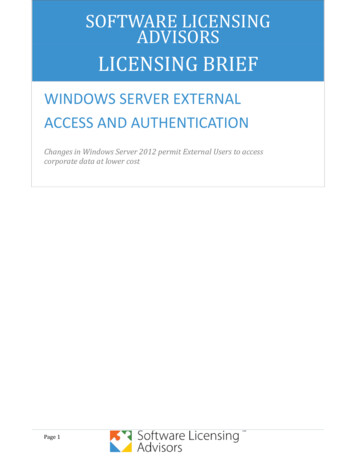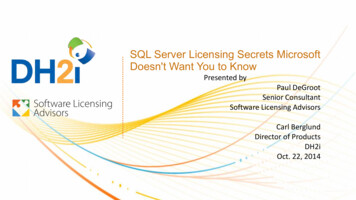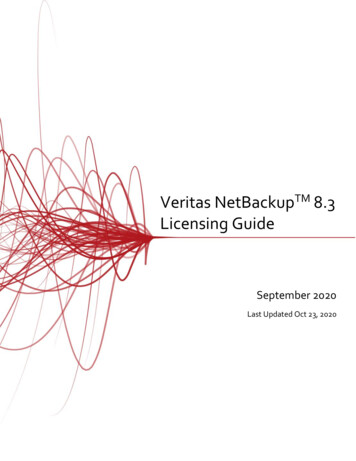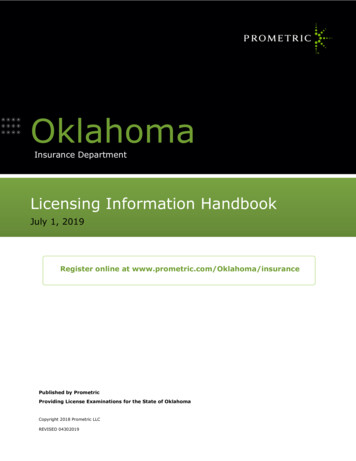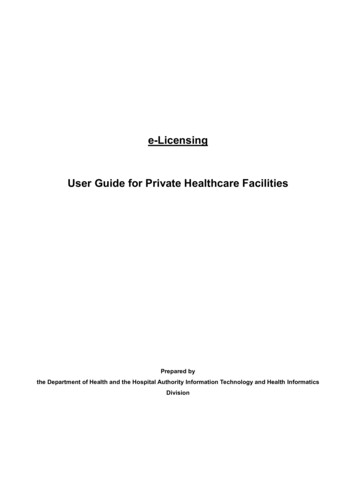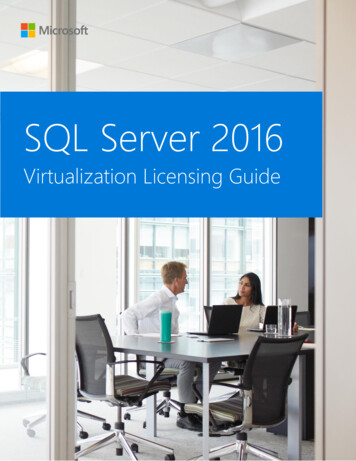
Transcription
Enterprise Software LicensingPresented by Julie Machal‐FulksPartner Scott & Scott, LLPwww.ScottandScottllp.com
Enterprise Software LicensingAgendaLicensing ModelsHistoric, Copy-centric metricsModern, Infrastructure-centric metricsLicensing ConcernsInfrastructure assessmentsVirtualizationChoosing the right kind of license agreementAuditsScope & confidentialityData collectionResolutionCopyright 2013 – Scott & Scott, LLP
Enterprise Software LicensingHistoric Licensing Models Software licensing in the recent past has beenthe software installation itself. Primarily copy-centric metric for determininglicensing obligations. For each installation of a program, acorresponding license has been required,mostly without regard to the performancequalities of the computer on which theprogram is installed.Copyright 2013 – Scott & Scott, LLP
Enterprise Software LicensingHistoric Licensing Models:Exceptions Server/CAL For each installation of the server software, acorresponding license is required. For each remote client accessing the server software, acorresponding client-access license (CAL) is required. Other, additive CALs have been available to “unlock”certain features of the server software (e.g., TerminalServices / Remote Desktop CALs). Custom licensing agreements based on uniquecharacteristics of the software to be licensed and thenetwork or networks where it is to be used.Copyright 2013 – Scott & Scott, LLP
Enterprise Software LicensingNew Licensing Models:“Custom” is the New Normal More options and flexibility for software needs. Often complex software asset management (SAM)obligations accompany custom agreements. Businesses must equip themselves to recognize theunique challenges entailed with the various options inorder to avoid unnecessary licensing exposure.Copyright 2013 – Scott & Scott, LLP
Enterprise Software LicensingNew Licensing Models:Workstations Single-seat / stand-alone Pros: Relatively easy accounting, relatively easy IT support Cons: Inflexible, can be more costly to scale Thin clients Pros: Easier to scale, central control over deployments Cons: Hardware deployments can be more expensive andtechnically demanding, more limited vendor options The Cloud Pros: Easiest to scale, little and sometimes no licensemanagement responsibility Cons: Loss of control, requires special attention to vendorcontracting and relationship managementCopyright 2013 – Scott & Scott, LLP
Enterprise Software LicensingNew Licensing Models: Servers Server installation (with or without clients) ProcessorLicenses are acquired based on the number of processor chipsactivated and available in the computer – typically allows unlimitedclients . Processor capacityLicenses are acquired based on the strength of the computer’sprocessor(s) – most prominent example is IBM’s processor valueunit (PVU) licensing model. Function-specific capacityLicenses are acquired based on some other metric that ischaracteristic of how software is used (e.g., licensing for a backupsolution that is based on the volume of data backed up using thatsolution). The CloudCopyright 2013 – Scott & Scott, LLP
Enterprise Software LicensingLicensing Concerns:Infrastructure Assessments Businesses must be able to determine what hardware itowns and what software it needs. Internal auditing is necessary in order to gather informationabout the enterprise’s IT infrastructure. Principal challenges include: Diverse hardware types and configurations cancomplicate the inventory process. Need to gather division-level or even employee-levelinput while minimizing division-level and evenemployee-level involvement in the licensing process. Technical expertise to interpret raw data may resideoutside the enterprise.Copyright 2013 – Scott & Scott, LLP
Enterprise Software LicensingLicensing Concerns: VirtualizationMany software publishers limit – in one way or another – theircustomers’ ability to license software in virtualized environments,for example: Microsoft often caps the number of virtual “operatingsystem environments” in which a software product may beinstalled, depending on the edition of the software to bedeployed (e.g., SQL Server Datacenter versus SQL ServerEnterprise). IBM often requires that a server or cluster be licensed to itsfull processor capacity for a software product – even if onlyone virtual machine hosted on the server or cluster isrunning that product – unless the company agrees to thetechnical and procedural requirements for “sub-capacity”licensing, allowing for license acquisition at the virtualserver level.Copyright 2013 – Scott & Scott, LLP
Enterprise Software LicensingLicensing Concerns:License Agreement TypesRetail EULARetail EULAs do not offer any opportunity for custom terms, andpricing typically is not competitive for large license purchases.Volume LicensingMost terms remain “off-the-shelf” forms that offer little, if any,room for customization and that also typically include onerous auditrights terms in favor of the publisher.Enterprise-Level AgreementsIncreased flexibility may also have higher front-end costs: Higher up-front license-purchase requirements. Necessity of legal review and (in many cases) negotiationwith counsel for the software publisher. Need for IT teams to implement new solutions or proceduresto correctly track deployments and licenses under theapplicable agreement or agreements.Copyright 2013 – Scott & Scott, LLP
Enterprise Software LicensingSoftware Audits:Scope & ConfidentialityMost software publishers, by default, include relatively onerousaudit-rights provisions in their form agreements: Only “reasonable” restraints on audit timing and frequency. No express limitations on scope of potential audits (either legal,geographic or product-specific). Few or no meaningful protections for information disclosed by theenterprise during the course of the audit (either as to confidentiality or toadmissibility in court, in the event litigation arises). Burdensome resolution terms: License purchases for unlicensed deployments, regardless of use Back-maintenance purchases for unlicensed deployments (or, insome cases, a percentage over the MSRP licensing costs) Obligation to pay the publisher’s third-party auditor, in the eventthat any compliance gap exceeds a stated threshold.Copyright 2013 – Scott & Scott, LLP
Enterprise Software LicensingSoftware Audits:Preliminary FrameworkAt the onset of any audit, it is vital to try to obtain thepublisher’s agreement (in writing) as to: Computers and products to be included in the inventory. Requirement that all audit materials and audit-relatedcommunications be maintained confidential. Prohibition on using any audit materials or audit-relatedcommunications for any purpose (including litigation).other than conducting and resolving the audit.Copyright 2013 – Scott & Scott, LLP
Enterprise Software LicensingSoftware Audits:Data CollectionData-collection challenges within the context of a software auditgenerally are the same as those within the context of regularinventory processes: “Document soup” complicates license tracking Tools to assist with network inventories may not capture allnecessary information. Much heightened need to gather employee-level input whileminimizing employee involvement in the audit process. Technical expertise to interpret raw data may reside outside theenterprise.Copyright 2013 – Scott & Scott, LLP
Enterprise Software LicensingSoftware Audits:Exposure Analysis Internally assessment of financial exposure criticalbefore any information is disclosed to the auditingentity. Identify inventory data that may be erroneous orinfrastructure details that may affect licensingobligations.Copyright 2013 – Scott & Scott, LLP
Enterprise Software LicensingSoftware Audits: Resolution Negotiate defined audit-resolution terms at the licensing stage. During the audit, license terms give the publishers anunacceptable amount of leverage when it comes to driving theaudit process. Offer to purchase licenses of equal value to cover prospectiveneeds. Instead of retroactive support or maintenance, offer to commit toa longer or higher-level support term going forward. Obtain a release from the publisher at the end of the audit inorder to confirm the legal resolution of any compliancediscrepancies.Copyright 2013 – Scott & Scott, LLP
Enterprise Software LicensingQuestions?Copyright 2013 – Scott & Scott, LLP
Enterprise Software LicensingContact InformationJulie Machal‐Fulks, Esq.PartnerScott & Scott, LLP.1256 Main Street, Suite 200Southlake, TX 76092Phone: (214) 999‐2905Fax: (214) 999‐0333E‐Mail: jfulks@scottandscottllp.comCopyright 2013 – Scott & Scott, LLP
Enterprise Software Licensing Software Audits: Resolution Negotiate defined audit-resolution terms at the licensing stage. During the audit, license terms give the publishers an unacceptable amount of leverage when it comes to driving the audit process. Offer to purchase licenses of equal value to cover prospective needs.
